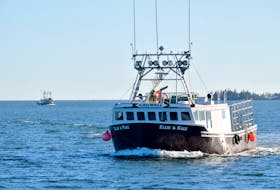
“A lot of people go there to get their water,” he said. “It’s very serious.”
The Westville resident was told by a friend who had the water tested, that it contained E. coli.
The News collected samples from the Greenhill spring, as well as a spring in Blue Mountain, and had them tested at a provincial laboratory via the Aberdeen Hospital. Another spring in the Mount Thom area was not tested.
While E. coli was not detected, test results from samples taken on Jan. 26 in Greenhill and Jan. 27 in Blue Mountain show coliform bacteria in both.
“The fact that it tested positive means it’s not to be considered safe,” said Nova Scotia Environment media relations advisor Heather Fairbairn.
In general, the provincial government advises people not to use water from roadside springs. “Nova Scotia Environment does not regulate or conduct water quality testing on natural springs or roadside wells,” she said.
She said studies of roadside springs in Nova Scotia found that about 90 per cent had total coliforms present and 20 per cent had Escherichia coli (E. coli) bacteria present.
“Using a natural or roadside spring as a source of water is not a safe option. It is very important the community doesn’t use roadside springs for drinking water. If someone chooses to use water from a roadside spring, they do so at their own risk.”
Fairbairn said in Nova Scotia, Canadian drinking water quality guidelines are followed, and no amount of coliform is acceptable. “Our message is, to avoid illness you have to avoid drinking the water (from these springs).”
Total coliform bacteria are used as an indicator of the general quality of the water and whether drinking water is potable.
Fairbairn said the only way to be safe is to drink water from a properly constructed and maintained private well that’s regularly tested, or from a municipal source. Municipalities treat the water before distribution and consumption by consumers, and regularly monitor the quality of the water.
A natural spring is a place where groundwater flows to the surface and is released from the ground. Before modern well-drilling equipment was invented, natural springs were commonly used as a source of drinking water. But, the provincial government said natural and roadside springs are not considered to be a reliable, safe water supply.
According to information on the Environment Department’s website, while many people believe spring water is pure, natural, better tasting and free of contaminants when compared with private wells or local municipal water supplies, these opinions aren’t scientifically valid. Groundwater may be relatively pristine, but as it makes its way to the surface it can become contaminated.
The main source of pathogens in drinking water is through contamination from human or animal waste, from improperly treated septic and sewage discharges, leaching of animal manure, storm water runoff and domestic animals or wildlife. “
The sources of contaminants in natural springs are numerous. Animal defecation is but one example. Naturally-occurring elements in our geology, temperatures, heavy rainfall and water run-off also can affect ground and surface water supplies,” said Fairbairn.
Water in a natural spring can also become contaminated when man-made products such as gasoline, oil, road salts, and chemicals leach into surface water or groundwater.
“Different things can affect ground and surface water supplies at different times of the year. In the absence of treatment, we could never say that the water from natural springs is safe to drink.”
According to the Department of Environment, historical results indicate that the water quality of roadside springs fluctuates. At different times, coliform bacteria can be absent or present at the same spring.
Pathogens can be destroyed by boiling water for at least one minute, but this will not remove chemical contaminants, said Fairbairn. “Even with boiling, in the absence of regular testing and treatment we could never say that the water is safe to drink.”
QUICK FACTS
• Coliform bacteria are used as a measure of the degree of pollution and the sanitary quality of well water.
• Coliform bacteria can be detected through laboratory testing. The lab reports the presence or absence of total coliform bacteria and Escherichia coli (E. coli).
• In water, coliform bacteria have no taste, smell, or colour. They can only be detected through a laboratory test.
• Do not assume that water is safe to drink just because it has not made anyone sick in the past. If bacteria are present in water, a risk exists that it could cause illness.
• If bacteria are found in water, it is not safe for drinking, preparing infant formula, preparing juices and ice cubes, washing fruits and vegetables, cooking or brushing teeth.
Source: Nova Scotia Environment
What you need to know
Total coliforms and E. coli are used as indicators to measure the degree of pollution and sanitary quality of water, because testing for all known pathogens is a complicated and expensive process.
What is coliform?
Total coliforms are a group of bacteria commonly found in the environment, for example in soil or vegetation, as well as the intestines of mammals, including humans. Total coliform bacteria are not likely to cause illness, but their presence indicates that the water supply may be vulnerable to contamination by more harmful microorganisms.
What is E. coli?
E. coli (Escherichia coli) are bacteria that normally live in the intestines of humans and warm-blooded animals. The presence of E. coli in water indicates recent fecal contamination and may indicate the possible presence of disease-causing pathogens, such as bacteria, viruses and parasites. Although most strains of E. coli bacteria are harmless, certain strains, such as E. coli O157:H7, make toxins that can cause diarrhea and more severe illness.
Health Risks
The most common symptoms of waterborne illness include nausea, vomiting and diarrhea. Infants, the elderly and those with compromised immune systems may suffer more severe effects. In extreme cases some pathogens may infect the lungs, skin, eyes, nervous system, kidneys or liver. Some E. coli strains cause bloody diarrhea, food poisoning, urinary and digestive infections, and sometimes can be fatal to humans.
Source: Nova Scotia Environment








